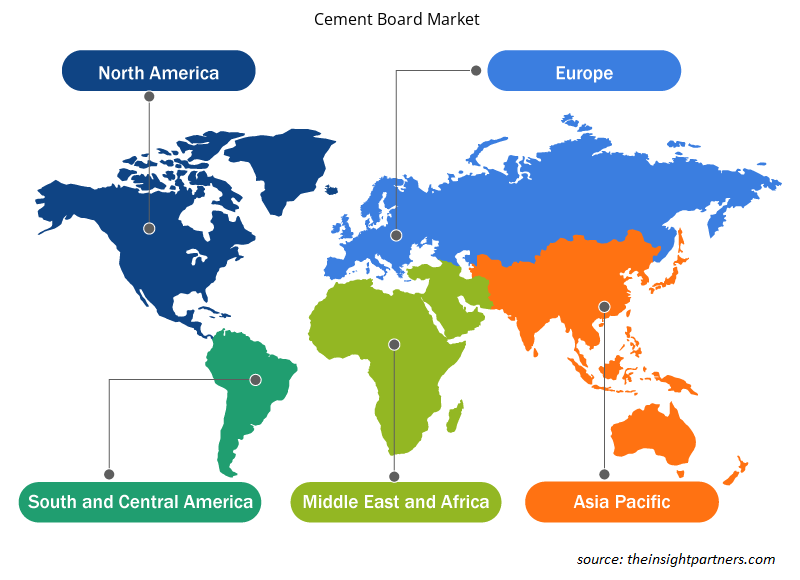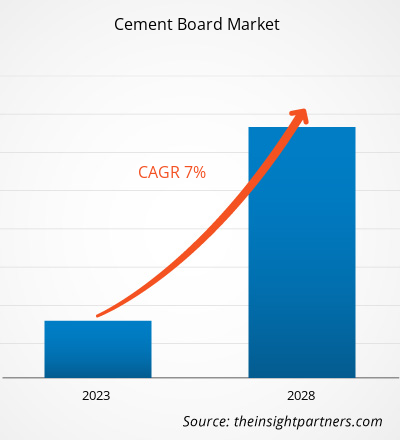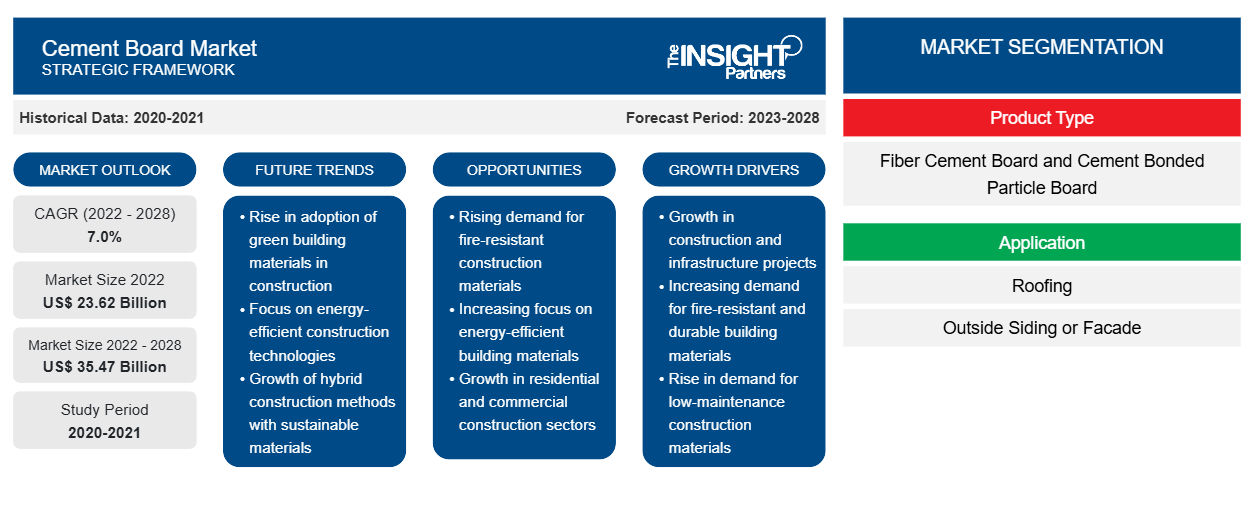[研究报告] 水泥板市场规模预计将从 2022 年的 236.1663 亿美元增长到 2028 年的 354.7356 亿美元;预计 2022 年至 2028 年的复合年增长率为 7.0%。
市场分析
水泥板是水泥、玻璃、骨料和纤维增强材料的组合,制成板材后可用作瓷砖背板,也可用于建造墙壁或地板。水泥板包括各种产品类型,例如纤维水泥板和水泥粘合刨花板。水泥粘合刨花板具有高刚度、高防火性、高耐大气腐蚀性和出色的隔音性能。它们广泛用于地板、外墙、墙面覆层、大门和其他建筑产品。水泥板因其出色的物理特性(例如不燃、防水、防紫外线、防腐和防缠绕等)而用于各种建筑活动。
增长动力与挑战
建筑行业越来越多地采用水泥板,这大大推动了全球水泥板市场的增长。耐用性是水泥板最理想的品质之一。水泥板和面板的使用寿命通常比乙烯基壁板和其他替代产品更长。乙烯基壁板在 10 到 15 年内就会出现老化迹象,而水泥板的使用寿命可达 30 到 50 年或更长时间。此外,在水泥生产中,二氧化碳是一种副产品。然而,制造含有聚氯乙烯 (PVC) 的乙烯基壁板产生的二氧化碳比生产水泥更多。此外,乙烯基壁板在其整个生命周期内都会排放气体,因为它占据了垃圾填埋场的空间。此外,对节能建筑的需求激增进一步推动了全球水泥板市场的增长。发展中国家城市的现代化和人均收入的增加推动了世界各地建筑的能源使用。公共、住宅和商业建筑的高能耗产生了节能的需求。根据国际能源署的数据,到 2035 年,建筑预计将占全球节能潜力的 41%,工业部门和运输部门将分别占 24% 和 21%。在建筑物上铺设一层水泥板,以减少通过墙壁的热量传递,使室内在冬天保持温暖,在夏天保持凉爽,从而使建筑物节能。然而,水泥板购买和安装的高成本可能会限制其市场增长。
定制此报告以满足您的需求
您可以免费定制任何报告,包括本报告的部分内容、国家级分析、Excel 数据包,以及为初创企业和大学提供优惠和折扣
- 获取此报告的关键市场趋势。这个免费样品将包括数据分析,从市场趋势到估计和预测。
报告分类和范围
“2030 年全球水泥板市场分析”是一项专业而深入的研究,主要关注全球水泥板市场趋势和增长机会。该报告旨在概述全球水泥板市场,并按产品类型、应用、最终用途和地理位置对市场进行详细细分。全球水泥板市场近年来一直保持高增长,预计在预测期内将继续保持这一趋势。该报告提供了全球水泥板消费量的关键统计数据以及主要地区和国家的需求。此外,该报告还对影响主要地区和国家水泥板市场表现的各种因素进行了定性评估。该报告还包括对水泥板市场主要参与者及其关键战略发展的全面分析。还包括对市场动态的几项分析,以帮助确定关键驱动因素、市场趋势和有利可图的水泥板市场机会,进而有助于确定主要收入来源。
此外,生态系统分析和波特五力分析提供了全球水泥板市场的360度视角,有助于了解整个供应链和影响市场增长的各种因素。
节段分析
全球水泥板市场根据产品类型、应用和最终用途进行细分。根据产品类型,水泥板市场细分为纤维水泥板和水泥粘合刨花板。根据应用,市场分为屋顶、外墙或外墙等。
根据最终用途,市场分为住宅和非住宅。根据产品类型,纤维水泥板部分占据了相当大的水泥板市场份额,这可以归因于建筑行业对水泥板的采用日益增加。纤维水泥板是一种用途广泛且受欢迎的建筑材料,因为它耐用且耐火、防潮、防虫。这种板由水泥、沙子、纤维素纤维和水组成,通常用于住宅和商业建筑项目中的外墙、屋顶、地板和内墙。纤维水泥板重量轻且易于使用。因此,它受到建筑商和承包商的青睐。根据应用,外墙板或外墙占据了主要市场。纤维水泥外墙板或外墙可用作金属、传统木材和乙烯基外墙板或外墙的替代品。外墙板或外墙有各种纹理、颜色、尺寸和形状,使建筑师和建筑商能够创造独特且视觉上吸引人的设计。它具有耐用性和抗风化、腐烂、发霉和害虫等关键优势。根据最终用途,住宅部分在全球水泥板市场中占有重要份额。由于人口增加,对住宅建筑的需求正在推动。纤维水泥板和水泥粘合刨花板因其关键优势(包括防水和防白蚁)而被广泛用于住宅建筑。此外,快速的城市化、外籍人口的增加以及对低碳足迹环保住宅的需求不断增长,将在预测期内促进全球水泥板市场住宅部分的增长。这将进一步为整个行业增长吸引新的增长机会。
区域分析
报告详细介绍了全球水泥板市场,涉及五个主要地区,即北美、欧洲、亚太地区 (APAC)、中东和非洲 (MEA) 以及南美和中美。中东和非洲占据了相当大的市场份额,2022 年的价值超过 20 亿美元,预计到 2030 年将达到约 30 亿美元。建筑活动的快速增长,尤其是中东的建筑活动,为中东和非洲市场的增长做出了积极贡献。亚太地区预计也将在 2022 年实现可观的增长,价值超过 80 亿美元,这归因于该地区对节能建筑的需求不断增加,推动了全球水泥板市场的增长。北美预计也将在 2022 年实现可观的增长,价值超过 40 亿美元,这归因于人们对纤维水泥板的偏好超过木板,预计将推动全球水泥板市场的增长。
行业发展和未来机遇
合作、收购和新产品推出被发现是全球水泥板市场参与者所采用的主要策略。
- 2023 年 1 月,James Hardie Building Products 宣布与 Boise Cascade Company 建立新的分销合作伙伴关系。
- 2020 年 1 月,James Hardie Building Products 在拉斯维加斯国际表面活动 (TISE) 上展示了其采用 HydroDefense 技术的 HardieBacker 水泥板。
水泥板市场区域洞察
Insight Partners 的分析师已详尽解释了预测期内影响水泥板市场的区域趋势和因素。本节还讨论了北美、欧洲、亚太地区、中东和非洲以及南美和中美洲的水泥板市场细分和地理位置。

- 获取水泥板市场的区域特定数据
水泥板市场报告范围
| 报告属性 | 细节 |
|---|---|
| 2022 年市场规模 | 236.2亿美元 |
| 2028 年市场规模 | 354.7亿美元 |
| 全球复合年增长率(2022 - 2028) | 7.0% |
| 史料 | 2020-2021 |
| 预测期 | 2023-2028 |
| 涵盖的领域 | 按产品类型
|
| 覆盖地区和国家 | 北美
|
| 市场领导者和主要公司简介 |
|
水泥板市场参与者密度:了解其对业务动态的影响
水泥板市场正在快速增长,这得益于最终用户需求的不断增长,而这些需求又源于消费者偏好的不断变化、技术进步以及对产品优势的认识不断提高等因素。随着需求的增加,企业正在扩大其产品范围,进行创新以满足消费者的需求,并利用新兴趋势,从而进一步推动市场增长。
市场参与者密度是指在特定市场或行业内运营的企业或公司的分布情况。它表明在给定市场空间中,相对于其规模或总市场价值,有多少竞争对手(市场参与者)存在。
在水泥板市场运营的主要公司有:
- 詹姆斯哈迪工业公司
- Plycem美国有限责任公司
- 珠穆朗玛工业有限公司
- Swisspearl 集团
- 维萨卡工业有限公司
免责声明:上面列出的公司没有按照任何特定顺序排列。

- 了解水泥板市场顶级关键参与者概况
新冠疫情的影响/地缘政治形势的影响/经济衰退的影响
COVID-19 疫情导致全球许多行业的发展放缓。全球制造工厂的关闭和贸易限制导致全球制造商的供应链受限。COVID-19 疫情对化学品和材料行业以及水泥板市场的增长产生了不利影响。为抗击 SARS-CoV-2 传播而采取的措施对各行业的增长产生了负面影响。由于国家和国际边界突然关闭,包装、消费品、汽车和运输、纺织和建筑等行业受到运营效率和价值链突然中断的不利影响。在 COVID-19 疫情期间,收入下降和项目交付挑战增加导致该行业在大多数市场萎缩,并对劳动力产生了相应的负面影响。由于许多工厂长期关闭,建筑商经历了进口原材料和场外建筑材料的延误和成本增加。建筑业的损害阻碍了对水泥板的需求。因此,水泥板市场在疫情过后恢复得相当好,预计未来几年将继续增长。
竞争格局和主要公司
水泥板市场的一些主要参与者包括 James Hardie Industries plc、Plycem USA LLC、Everest Industries Ltd、Swisspearl Group AG、Visaka Industries Ltd、Nichiha Corp、Soben International Ltd、SCG Building Materials Co., Ltd、Etex NV 和 Compagnie de Saint Gobain SA 等。
- 历史分析(2 年)、基准年、预测(7 年)及复合年增长率
- PEST和SWOT分析
- 市场规模、价值/数量 - 全球、区域、国家
- 行业和竞争格局
- Excel 数据集
近期报告
客户评价
购买理由
- 明智的决策
- 了解市场动态
- 竞争分析
- 客户洞察
- 市场预测
- 风险规避
- 战略规划
- 投资论证
- 识别新兴市场
- 优化营销策略
- 提升运营效率
- 顺应监管趋势























 获取免费样品 - 水泥板市场
获取免费样品 - 水泥板市场